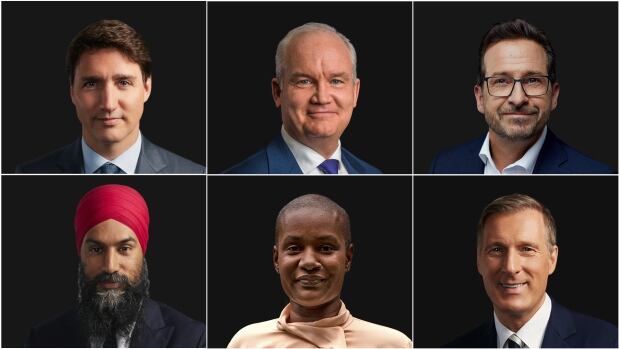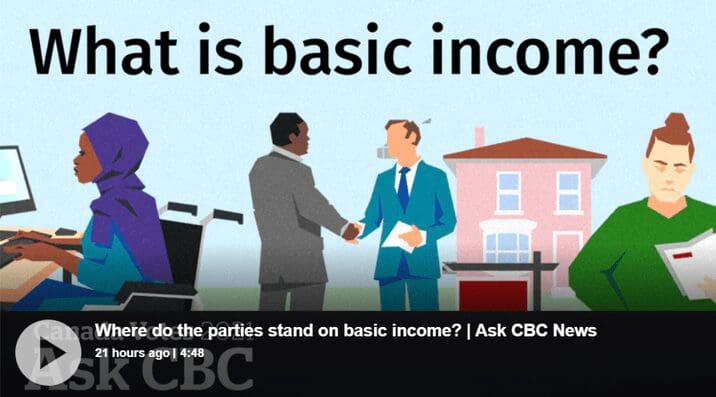The Canada emergency response benefit renewed calls for establishing a national livable income program
By: Jaela Bernstien
When the federal government launched the Canada emergency response benefit (CERB) last year, it left some wondering whether it could lead to a lasting framework for a national basic income program — one that would help lift struggling Canadians out of poverty.
While it was a temporary program, CERB provided a touchstone for many who wondered, if the country can create a standard livable wage during a pandemic, why stop there?
Port Elgin, Ont., resident Mini Jacques was one of many who reached out to Ask CBC to find out where the parties stand on basic income during this election.
“It doesn’t seem like there’s an even playing field for basic living,” she said in an interview.
“The government is saying that for CERB, people get $2,000 just to exist and yet … [we] haven’t had a raise in disability for some time.”
Jacques is blind and relies on the Ontario Disability Support Program for income. Her rent costs $1,022 monthly and she receives $1,169 through ODSP. That leaves her just $147 a month to cover the remaining necessities.
She works part-time to supplement those benefits, but if she earns more than $200 monthly, half of her take home earnings over $200 are deducted from her income support.
Her rent is increasing, and she worries that her ODSP cheques won’t increase at the same pace. She’s 61 years old, and for now she said she’s getting by with the help of friends and family.
What Jacques wants is for the government to create a basic income program that sets the same standard income for everyone who needs help — whether you’re unemployed, disabled, or working but not earning enough to stay above the poverty line.
What is basic income?
What makes basic income different from other programs, such as income assistance or welfare, is that it comes with no strings attached. In the simplest terms, it’s a regular payment without conditions, sent from the government to families and individuals.
In Canada about 3.7 million people live below the poverty line, according to the 2019 Canada Income Survey. Statistics Canada considers people as living below the poverty line if they don’t have enough income to cover the local cost of necessities such as food, clothing, footwear, transportation and shelter.
Right now, struggling Canadians can access help support through a patchwork of federal, provincial and municipal programs.
Health economist Evelyn Forget, a professor in the department of health sciences at the University of Manitoba in Winnipeg, said that basic income would replace many of those programs, and ideally cut out a lot of the confusing, bureaucratic red tape.
Forget, the author of Basic Income for Canadians: from the COVID-19 emergency to financial security for all, is a firm believer in the benefits of basic income.
She explained there are two types:
- Universal basic income (UBI) means that everyone in a society — rich or poor — gets a monthly cheque for the same amount. At the end of the year, the government uses the tax system to balance out the scales and recoup that extra cash from the higher income earners who didn’t end up needing it.
- Guaranteed basic income (GBI) is the system most people are referring to when they talk about basic income in Canada. It is an income-contingent system, meaning monthly payments only go to families and individuals with lower income.
The CERB program was not, in fact, basic income, because there were conditions to qualify: Canadians were only eligible if they had earned at least $5,000 in the last year.
Because the cost of living varies across Canada, there’s no single income level that defines poverty. But Forget said generally, advocates have talked about setting guaranteed basic income at around $20,000 a year for a single person between the ages of 18 to 64.
Where has it been tested and how well did it work?
Countries around the world, including Spain, Namibia, Brazil and Iran, have experimented with basic income, mostly through pilot projects and trial runs.
In Canada, Manitoba ran a pilot project called Mincome from 1974 to 1978 in the rural community of Dauphin.
The idea was to test whether a no-strings attached wage would actually help the working poor by supplementing their income, or end up deterring them from working altogether.
Forget studied the outcomes of that project and found that participants were less likely to be hospitalized and more likely to continue their education.
She said for the most part, basic income did not discourage people from working. One of the groups who worked less were new mothers who, in the 1970s in Manitoba, would have only been entitled to a few weeks of parental leave.
The other group that was disincentivized to work by basic income was young, unattached males. Forget discovered the reason those young men, often in their teens, were less likely to work was because basic income meant their families could afford to let them stay in school. Instead of dropping out to earn wages, they were able to get their high school diplomas.
“The fundamental idea behind basic income, I think, is solid,” she said.
“Unconditional money available to people allows them to make choices about their own lives, allows them to make better decisions about how to live their lives, and leads to better outcomes.”
More recently, Ontario introduced a basic income pilot project in 2017. Close to 4,000 people were enrolled and it was supposed to last three years, but was cancelled early following the election of Doug Ford’s Progressive Conservative government. They said the program was too expensive.
A 2021 report by Canada’s Parliamentary Budget Officer found that, if the federal government created a national basic income program similar to Ontario’s, it would cost around $85 billion in 2021-2022 and cut poverty rates by almost half.
“It costs a lot, no question about it,” Forget said.
However, she added that a lot of that cost would be balanced out by eliminating the programs basic income would replace, which might include income assistance or various refundable tax credits.
“A simplified process is always cheaper. It’s always more efficient,” she said.
What are the disadvantages?
In 2018, the government of British Columbia asked a panel of experts to study the feasibility of a basic income for the province. The resulting report found that “the needs of people in this society are too diverse to be effectively answered simply with a cheque from the government.”
Panel chair David Green, a labour economist and a professor at the Vancouver School of Economics at the University of B.C., said the better solution is to reform the programs that already exist.
“If our problem is really, the full heterogeneous, complex issue of poverty — how do we make a more just society — then, in many cases, sending people a cheque and hoping they will do better is not going to answer the problem,” Green said.
Green said it would be better to tackle issues head-on, targeting poor working conditions and low wages, reforming the disability assistance program and boosting rent assistance.
Still, others believe basic income is the right solution for Canada.
Two of the calls for justice in the final report from the National Inquiry into Missing and Murdered Indigenous Women and Girls said Canada should establish a guaranteed livable income for all.
Where do the main parties stand?

Like economists, Canada’s main parties are also divided on basic income, though none are promising universal basic income. Here’s where they stand:
The Green Party:
- Platform commits to establishing a guaranteed livable income program.
- “The federal government would provide an initial base-level subsidy across the country, and an intergovernmental body would determine and administer the necessary supplemental amounts.”
The NDP:
- Platform commits to a guaranteed livable basic income.
- “New Democrats will work to expand all income security programs to ensure everyone in Canada has access to a guaranteed livable basic income.”
- Would start by lifting seniors and people with disabilities out of poverty, and build on that to establish a basic income for all.
The Liberal Party:
- No platform commitment to basic income.
- Strong support from within the party for a basic income program.
- Liberal MP for Davenport, Julie Dzerowicz, tabled a bill calling for a national basic income strategy in 2021. The bill died at the dissolution of parliament when the election was called.
The Conservatives:
- No platform commitment to basic income.
The Bloc Québécois:
- No platform commitment to basic income.
The People’s Party of Canada:
- No platform commitment to basic income.
______________________________________________________
About the Author: Jaela Bernstien is a Montreal-based journalist reporting on news and current affairs. She has covered election campaigns, criminal trials, riots and natural disasters, and even once explored an ice-age cave.
Original article: https://www.cbc.ca/amp/1.6179760




















